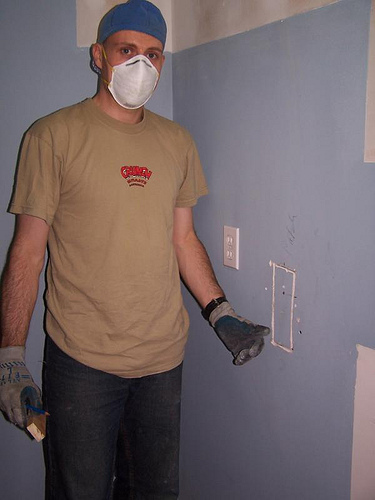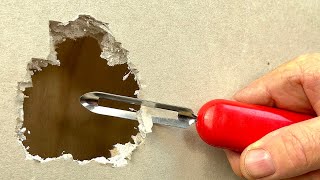[post_name ceiling texture Repairing Chips and Scratches in Dryall and Wood Work

Sheetrock is a sort of drywall and is produced and also a trademarked item by US Plaster Business, among the leading suppliers of drywall in the globe. It is additionally referred to as plaster wallboard. Sheetrock is a mix of natural gypsum, water, as well as sand that is pressed between 2 heavy sheets of paper. It is a building product that is utilized globally to construct architectural components like ceilings as well as walls. It was developed in 1916 but it took one more thirty to forty years prior to it caught on with builders, that had actually commonly built walls from plaster.Benefits of sheetwork vs plaster & bull; It is quicker to mount sheetrock than it is to
• mount plaster & bull; Sheetrock can be repainted or keyed quickly after• it has actually been mounted so the structure of the office or home could be proceeded without any type of hold-up. With plaster it needs days or also weeks to completely dry & bull; Plaster weighs even more compared to sheetrock so there is less damage on the
• structure's foundation as well as architectural systems & bull; There is a higher degree of fire-resistance with sheetrock compared to there is with platter. This could provide the ones in the building more time to exit the building safely in an emergency like a fire.Size of sheetrock The common sheet of sheetrock procedures 4 feet by 8 feet but also for buildings with specialized requirements
or have high ceilings the home builder could obtain larger areas. Usually, the indoor wall surfaces of a building are constructed from drywall that is one-half inch thick. If the structure's walls are going to undergo even more wear as well as tear, the building contractor can locate thicker sheets of five-eights thick. If there is a rounded wall surface, a home builder could use sheetrock that is quarter inch thick. The sheets of sheetrock can be formed due to the fact that they are reasonably flexible.Types of sheetrock There are several kinds of sheetrock that could be used for different applications. & bull; Traditional-it is normally fireproof however the contractor could pick Type-X,
which is fire-rated sheetrock. This sheetrock is enhanced with vermiculite as well as perlite to raise its resistance to flames and warmth.
• Building contractors make use of Type-X drywall in business structures, which has fire-rated rankings from twenty to one hundred eighty mins. & bull; Greenboard-this gets its name from its eco-friendly paper finishing, which is a product that is moisture-proof and is made use of in washrooms as well as kitchen areas. & bull; Blueboard-this is the type that a builder would certainly pick if the owners want the walls to have the look of plaster. & bull; Soundboard-this kind of sheetrock is created to obstruct the transmission of noise between different rooms.
• It can be set up in multiple layers to make certain that the levels of sound could be maintained.
Drywall Water Damage Ceiling Repairs
For small holes up to about & frac12;" you can merely make use of spackling substance and also a putty blade. Apply the spackle, wait up until it dries out after that sand smooth. Spackling substance will reduce a bit so often you will have to use a second layer after the first layer dries, you will then require to sand it again prior to repairing the paint.For tool
openings 1/2" to 3" you will certainly have to get a drywall patch (there are various other techniques to fix a hole this dimension yet a drywall patch package is the easiest). A lot of these kits feature a patch that is self adhesive. Just reduce the patch to ensure that it is bigger compared to the dimension of the opening by regarding 1" as well as stick it over the opening (some kits actually allow you to stick the patch with the opening after that pull it tight behind the rear of the hole allowing you to complete simply the hole).
After that you will need drywall substance (which could be located in smaller containers compared to a gallon) or spackling compound. Using a wide blade putty blade (3" or broader), apply the compound over the patch as well as a few inches surrounding the opening, then after it dries, sand it smooth. You will certainly should repeat this step a few times up until you could no much longer see where the patch is, fining sand after each coat dries out. Ultimately, retouch the paint.For larger
holes 3" as well as larger it is normally best to change an area of the drywall. Locate where the closest stud is, then removed a rectangle around the hole including half of the size of the stud. Then, using the eliminated piece as a layout cut a fresh item of drywall to fit the opening. Area the drywall in the opening as well as use drywall screws to affix it to the stud. (It is also far better if you eliminated an item that is large sufficient to reveal fifty percent of 2 studs so that the drywall is also stronger in location. Studs are generally positioned 18" apart yet could be anywhere between 12" to 24" apart.)
Using you "mudding blade" (or large putty blade), use a thin layer of drywall mud to cover the whole joint. Next off, apply paper drywall tape over the mud and also utilizing your blade, installed the paper strongly into the mud, removing any kind of excess mud. After this dries out use an additional 2 to 3 layers of drywall mud over the joint tape prolonging approximately 6" on either side of the joint, sanding in between each coat. When the repair work is smooth you can retouch the paint.

Dry Wall Patching - 5 Steps to Successfully Repairing a Hole in the Wall
Drywall repair Palm Beach Gardens - how to fix a hole in the wall
